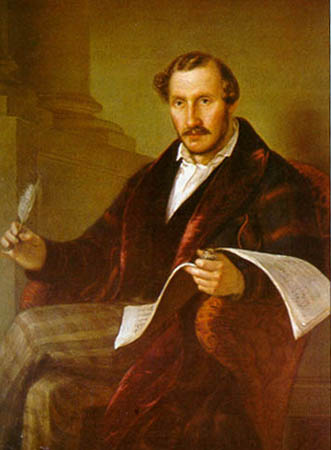Gaetano Donizetti
b Bergamo, November 29, 1797; d Bergamo, April 8, 1848
With nearly 70 operas to his credit, Gaetano Donizetti was the leading Italian composer in the decade between Vincenzo Bellini’s death and the ascent of Giuseppe Verdi. Donizetti was born in the northern Italian city of Bergamo to an impoverished family. After showing some musical talent, he was enrolled in the town’s Lezioni Caritatevoli, where he had the good fortune to study with Giovanni Simone Mayr, maestro di cappella at Santa Maria Maggiore. Originally from Bavaria, Mayr was a successful composer in Italy during the era preceding Gioachino Rossini’s rise to fame, with dozens of operas to his credit. Though offered many prestigious appointments throughout Europe, Mayr remained loyal to his adopted community and greatly enhanced the local musical institutions. Donizetti arrived at a time when Mayr was writing his greatest operas, and his impression on the younger composer was pronounced. Throughout his life, Donizetti regarded him as a second father, though he would outlive his master by only three years.
When it came time, Donizetti furthered his education at the Accademia Filarmonica in Bologna (shadowing Rossini, who had once studied there). He had already penned several short operas before receiving his first commission in 1818 from the Teatro San Luca in Venice – this was Enrico di Borgogna to a libretto by Bartolomeo Merelli. (In later years, as impresario of La Scala, Merelli was instrumental in the beginnings of Verdi’s career.) Further works were produced in Venice, but Donizetti returned to Bergamo for a few years of relative inactivity. A letter of introduction from Mayr to poet Jacopo Ferretti led Donizetti to Rome, where in 1822 he would have his first unequivocal success, Zoraide di Grenata. His career was just getting started.
Later that year Donizetti settled in Naples and used it as a base for the next 16 years. He arrived just as Rossini was finishing his seven-year contract with the royal theaters. Like Rossini he had the ability to work at the increasingly rapid pace demanded by the Italian theater industry and was able to produce three to four operas a year for most of his life.
Many remain timeless gems. L’elisir d’amore (1832), La fille du régiment (1840) and Don Pasquale (1843) demonstrate his expert handling of lighter subjects. Lucrezia Borgia (1833), Gemma di Vergy (1834), Lucia di Lammermoor (1835), Maria de Rudenz (1838) and Maria Padilla (1841) display the composer’s mastery of the Italian melodrama fueled by impassioned and unrestrained literature of the Romantic period. His influence on Verdi cannot be underestimated.
Donizetti’s success in dealing with both comic and tragic settings was due in part to his own manic depressive personality. Well acquainted with personal misfortune, Donizetti lost in the span of eight years his mother, father, two infant sons, an infant daughter and Virginia Vasselli, his wife of seven years. He never truly recuperated after her death, locking the door to her room and refusing to utter her name again. His melancholia may have been induced by early symptoms of syphilis, which he contracted as a young man. It may have also been brought on by the responsibility he felt for harboring the disease that likely cost him his wife and children.
Donizetti made his Paris debut in 1835 with Marino Faliero at the Théâtre Italien and later premiered Les martyrs (1840) at the Paris Opéra. A French translation of Lucia made his name a household word, and in 1840 the composer captivated audiences with La favorite, which became hugely popular throughout Europe and North America. One of his very last works for the stage, Dom Sébastien (1843), was cast in the mold of French grand opéra and was extremely well-received.
The composer had hoped to assume Niccolò Zingarelli’s post as director of the Naples Conservatory, but when the 85-year-old composer died in 1837, Donizetti’s considerable musical contribution to the city was overlooked. Preference was given to a lesser composer, Saverio Mercadante, chiefly because he was a native Neapolitan. After his brief stint in Paris, Donizetti turned toward the Austrian state, where he became music director of the imperial theaters. Two of his final works had their premiere at Vienna’s principal venue, the Kärntnertortheater: Linda di Chamounix (1842) and Maria di Rohan (1843). After the success of Linda, he was appointed Composer to the Austrian Court, a position Mozart had held a half century earlier.
By 1845, symptoms of his illness had become incapacitating, and his erratic behavior could no longer be excused by overwork. With his family’s intervention Donizetti was placed in a French sanitarium at Ivry for 17 months, then transferred to a Paris apartment. There he was regularly visited by musicians and colleagues, including Verdi, but by this point he was paralyzed, disoriented and rarely spoke. In September 1847, friends arranged his return to Bergamo, where he passed his final days at the home of a wealthy patroness.
